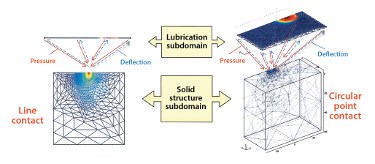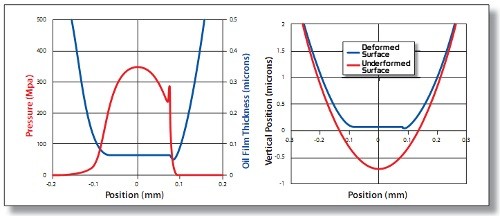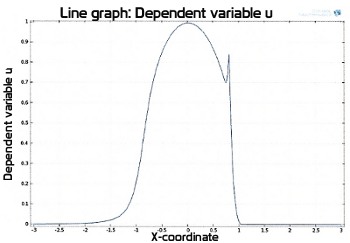 |
| September 25, 2012 | Volume 08 Issue 36 |
Designfax weekly eMagazine
Archives
Partners
Manufacturing Center
Product Spotlight
Modern Applications News
Metalworking Ideas For
Today's Job Shops
Tooling and Production
Strategies for large
metalworking plants
Shell optimizes lubricants using COMSOL
Shell is using simulation to find and optimize the right lubricants in complex friction problems. Up until recently, Dr. Robert Ian Taylor and his team have used proprietary programs to simulate these applications. But as they increase the ambitions and complexity of their simulations, they are now turning to COMSOL Multiphysics.
By Jennifer Hand

Figure 1. Schematic of multiphysics approach to solving lubrication problems. The Reynolds' equation is solved on the line, or surface. The calculated pressure distribution is then used to calculate elastic deformations and this process is repeated until convergence is obtained.
Lubricants are increasingly being seen as critical to fuel economy, and this has become one of the main drivers for development. Lubricants that can deliver better fuel economy or improved energy efficiency are in demand, and the market is huge. Independent consultants Kline & Company estimate that the global requirement in 2010 was almost 38 million tons, approximately 44 billion liters. According to Dr. Robert Ian Taylor, technology manager at Shell Research in the U.K., a reduction in lubricant viscosity is regarded as one of the key approaches to energy efficiency, and the choice of base oil is significant.
"There is a move towards synthetics, in which molecules are highly controlled, often by further processing of mineral base oils. 'Slippery' chemical additives, called friction modifiers, are also being used," says Dr. Taylor.
In general, energy-efficient lubricants deliver lower friction because the oil film thickness in the contact is reduced.
Of course, if oil-film thickness is reduced too much, there is the possibility of higher wear. It is therefore particularly important to be able to predict the effect of lubricant properties on the thickness of the oil film and the friction of a lubricated contact.
"For lubricated contacts, such as plain journal bearings or piston rings, and pressures below 200 MPa, the Reynolds' equation can easily be solved to predict oil film thickness and friction," says Dr. Taylor. "However, there are many important lubricated contacts, such as gear teeth or rolling element bearings, where extremely high pressures up to 3 or 4 GPa can be generated in the lubricant. Under such pressures, the viscosity of the lubricant increases dramatically, causing metal surfaces to deform elastically. As a consequence of these two effects, the oil-film thickness is greater than otherwise expected, which is exactly why such high-pressure contacts can be successfully lubricated. The fact that high pressure promotes lubrication rather than hinders it can seem a bit non-intuitive. The key is to account for these two effects when predicting performance."
This type of lubrication is known as elastohydrodynamic lubrication, and as Dr. Taylor notes, it is no easy matter to measure lubricant rheology, or flow, under such pressures, especially as shear rates can also be as high as 108 s-1. "In elastohydrodynamically lubricated contacts, we generally have much thinner films than 1 micron, so shear rates are correspondingly higher," says Dr. Taylor. "Any mathematical models we develop must be capable of allowing for varying rheological descriptions of the lubricant."
For a lubricated line contact, such as the sliding of a cylinder against a flat surface under steady loading conditions, any equations used need to take account of numerous attributes. These include lubricant oil-film thickness at different positions in relation to the contact; the corresponding pressure that determines lubricant density; lubricant dynamic viscosity; the relative speed of moving surfaces; the reduced radius of curvature for the contacting surfaces; the reduced Young's modulus of the surfaces; and the load per-unit length.
"We end up with some rather complex analytical expressions for the elastic deformation of a medium due to an applied pressure at the surface," admits Dr. Taylor. "It is also worth pointing out that lubricant viscosity is a strongly varying function of pressure. The numerical solution of these equations is not straightforward, since the character of the partial differential equation changes at different points in the contact."
Finite element analysis, using a multiphysics solver, is an approach for taking into consideration all of the participating properties. "We wanted to solve the Reynolds' equation on the contact line or surface; find the pressure in the lubricant; use that calculated pressure to calculate the elastic deformation in the underlying surface; then use the changed surface shape to recalculate the pressure distribution," says Dr. Taylor (Figure 1).
The Shell team has found that this approach has converged reasonably well for pressures less than 1 GPa. For higher pressures from higher loads, it becomes necessary to dampen oscillations in the calculated pressure distribution. Dr. Taylor explains: "Small diffusive terms can be added to the Reynolds' equation, or even better, SUPG [Streamline Upwind Petrov Galerkin] methods can be used to add residual-based stabilizing terms to the original equation. This approach then enables successful simulation of contacts for pressures up to 4 GPa."
Over the years, the Shell team has conducted many simulations using a proprietary direct solver, which also uses adaptive meshing. The software, written in a mixture of FORTRAN and C, consists of approximately 20,000 lines of code, although this includes the solver code too. "This solver works very well for smooth surfaces; a small number of discretization nodes; 'simple' rheology, with no viscoelasticity; and it assumes Reynolds' equation holds," says Dr. Taylor. The results shown in Figure 2 are from this solver.

Figure 2. Typical calculated oil film thickness (red curves) and pressure (blue curves) for an elastohydrodynamically lubricated line contact. The simulations were performed for an oil temperature of 373 K and a contact entrainment speed of 10 m/s, which is typical for gear contacts. The results are from Shell's proprietary solver.
However, the proprietary solver code is not so straightforward to modify, and it sometimes poses a steep learning curve for newcomers. Members of the Shell team are increasingly turning to COMSOL Multiphysics for complex lubrication problems (Figure 3).
Over the past three years, the team has been using both systems to confirm that they obtain the same results from COMSOL Multiphysics as they do from their own solver. "It is still easy to use the solver for some problems, but we use COMSOL for more difficult issues," says Dr. Taylor. "One of the fundamental advantages of COMSOL is that we can develop models without any lines of code whatsoever. This makes maintenance and modification of models much simpler. It is also much easier when we need to consider real lubricated contacts. These are rough, at the micron scale, and so a typical 3-mm contact would need to be described by approximately 1,000 nodes, if we model it accurately. This would take up too much computer time and memory for the direct method used in the proprietary solver. Yes, we could use multigrid methods, but with this it is often necessary to 'tweak' the numerical parameters of the multigrid method in order to get convergence."

Figure 3. Calculation of pressure distribution in lubricated line contact, using COMSOL. The conditions are the same as those used in Figure 2.
The Shell team is also interested in lubricated "point contacts," such as rolling element bearings, as there are many billions of these in machines across the world. Some of them are lubricated with grease, a viscoelastic material, rather than a liquid lubricant.
"Whereas the Reynolds' lubrication equation cannot be used for viscoelastic fluids without significant modification, COMSOL could solve the same lubricated contact with the full Navier-Stokes equations, using the correct viscoelastic properties of the grease," Dr. Taylor says. "As most lubricated contacts are subject to time-varying loads, the ability to predict the time dependence of oil-film thickness and friction is essential. We have, in fact, already used COMSOL to look at such effects for gear teeth, which are effectively line contacts."
The accurate modeling of grease-lubricated rolling element-bearing contacts is now an active area of research for many companies, including Shell, and Dr. Taylor expects to be making even more use of COMSOL Multiphysics.
Source: COMSOL News 2012, reposted with permission from COMSOL.
Published September 2012
Rate this article
View our terms of use and privacy policy
